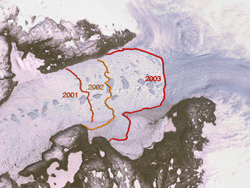NASA Study Finds Glacier Doing Double Time

A NASA-funded study found the world's fastest glacier, Greenland's Jakobshavn Isbrae, doubled its speed of ice flow between 1997 and 2003. The study provides key evidence of newly discovered relationships between ice sheets, sea level rise and climate warming. The study appears in this week's issue of the journal Nature.
Jakobshavn Isbrae is Greenland's largest outlet glacier, draining 6.5 percent of Greenland's ice sheet area. The stream's near-doubling of ice flow from land into the ocean is important, because this one glacier has increased the rate of sea level rise by approximately four percent of the 20th century rate of increase.
The study used data from satellites and airborne lasers to derive ice movements. Synthetic aperture radar from Canada's RADARSAT and the European Space Agency's European Remote Sensing Satellites' data was used to measure the glacier's velocity. Researchers tracked distinct features in NASA Landsat satellite image pairs to determine velocities.
"Other glaciers have thinned by over a meter a year, which we believe is too much to be attributed to melting alone," said Waleed Abdalati, a senior scientist at NASA's Goddard Space Flight Center, Greenbelt, Md., and co-author of the study. "We think there is a dynamic effect in which the glaciers are accelerating due to warming. This investigation furthers our understanding of ice-climate interactions of planetary systems."
Source: NASA
















